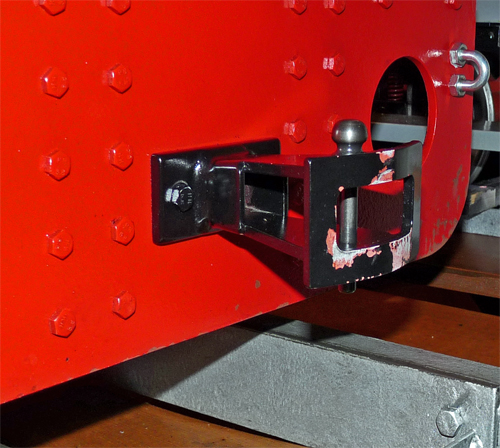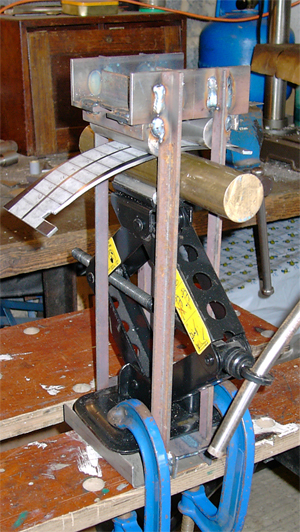 |
 |
 |
The "Bellmouth" Coupling
| As suplied the Stafford does not have any form of coupler fitted to the front buffer beam. This is not a problem unless you are going to use the locomotive to "double head" a train or need to be towed around as a result of a defect. However with these ideas in mind I decided to fit a coupling, and to make it more of a feature rather than the simple block used on the rear buffer beam I used a bellmouth coupling on a full size loco as a starting point for my design. In case you are wondering why an apparently "Functional" item is listed under "Cosmetic Modifications" it is because the coupler was not really expected to be used, and the relatively small front opening does limit the mobility of any drawbar used to connect the Stafford to anything else. | |
 The
coupling was designed using CAD to be made from three flat
plates
that would be laser cut from sheet steel and three sections of flat bar
stock. The coupling pin head was turned from steel bar and
silver
soldered to the shaft, and an 'R' clip that would ensure the pin could
not fall out was attached to the pin's head using 200 lb breaking
strain Dacron cord. The laser cutting was quickly done by The
Model Engineers Laser (see the links page for details). The
coupling was designed using CAD to be made from three flat
plates
that would be laser cut from sheet steel and three sections of flat bar
stock. The coupling pin head was turned from steel bar and
silver
soldered to the shaft, and an 'R' clip that would ensure the pin could
not fall out was attached to the pin's head using 200 lb breaking
strain Dacron cord. The laser cutting was quickly done by The
Model Engineers Laser (see the links page for details). The only awkward job left was to "roll" the front plate into a smooth curve, but I don't own a set of bending rolls that could cope with 1/8 inch mild steel plate. However many years ago when building a Class 90 locomotive I had constructed a crude bending machine using a car jack and scrap metal. The photo on the right shows the device in use bending the front plate for the Class 90, and surprisingly by simply using the bender at each of the marked lines it made a very smoothly curved plate. Once it had been dug out from the back of the garage and fitted with a new jack (and top bar, as the brass had long since been machined into various components) it easily shaped the couplings front plate. The various parts of the coupling were then welded together using my MIG welder and a simple jig to hold them in the correct position, although I did take a lot of care to ensure that the welds looked neat but had good penetration as I didn't want it to fall apart if it was ever used. The finished item was then etch primed (I always use ACID 8 aerosol etch primer) and finished gloss black with an aerosol can of Halfords standard car paint. The mounting bolts simply replaced two bolts already on the Stafford and screw into the chassis spreader behind the buffer beam for extra strength. As you can see in the photo the coupler is now looking distinctly used as a result of the Stafford having to push other dead locos back from the track on more than one occasion, and it has also been tested when double heading trains. So its construction has been worthwhile as it has saved the front buffer beam from damage when shunting and also allowed me to double head, which would be impossible without a front coupling. Its current state also fits in with my philosophy about how an engine should look (see the opening section on the cleaning page). Despite comments from fellow club members I steadfastly refuse to repaint it because; a) it simply looks like a "real" coupling in use would look, and b) if I repainted it within a few days it would probably be used and damaged again. |
|